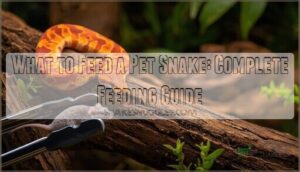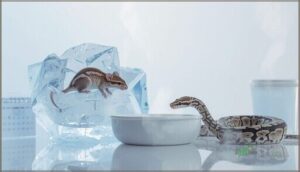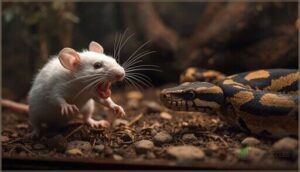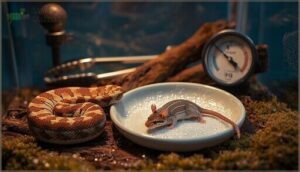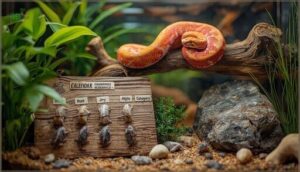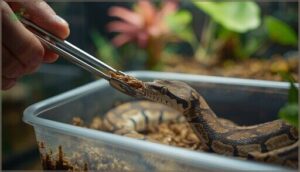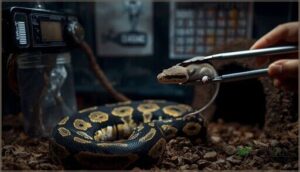This site is supported by our readers. We may earn a commission, at no cost to you, if you purchase through links.
Your new corn snake stares at the frozen mouse in your tongs, unimpressed and motionless. Meanwhile, your friend’s ball python devours rats with enthusiasm, and you’re left wondering if you picked the wrong prey—or worse, if your snake will starve.
The truth is that feeding pet snakes isn’t about guesswork or trial-and-error experiments with your animal’s health. Understanding what to feed a pet snake starts with recognizing that these obligate carnivores have evolved over millions of years to extract complete nutrition from whole prey items. Matching the right food to your specific species makes all the difference between a thriving snake and a struggling one.
Getting the diet right means knowing which prey types suit your snake’s natural preferences, how size and frequency affect digestion, and why the frozen-versus-live debate matters more than most new keepers realize.
Table Of Contents
- Key Takeaways
- What Should You Feed a Pet Snake?
- Choosing Between Frozen and Live Prey
- How Often Should You Feed Your Snake?
- Safe Feeding Practices for Pet Snakes
- Troubleshooting Common Snake Feeding Issues
- Frequently Asked Questions (FAQs)
- What do snakes eat?
- How do you feed a pet snake?
- Should a pet snake eat whole prey?
- How do you care for a pet snake?
- Can snakes eat substrate?
- Should you feed a snake live food?
- What can I feed my snake if I don’t have mice?
- How often are pet snakes supposed to eat?
- What should snakes not eat?
- What food is toxic to snakes?
- Conclusion
Key Takeaways
- Whole prey items like frozen-thawed rodents provide complete nutrition for pet snakes without supplements, with prey size matching roughly 10-15% of your snake’s body weight to prevent regurgitation and support healthy digestion.
- Frozen-thawed prey eliminates the serious injury risks that live feeding poses—including bites, infections, and stress-induced regurgitation—while offering convenient bulk storage and humane feeding practices.
- Feeding frequency shifts dramatically with age, from every 5-7 days for hatchlings to every 10-21 days for adults, with species-specific adjustments needed as metabolism slows with maturity.
- Feed your snake inside its enclosure using long-handled tongs to prevent defensive strikes, and watch for refusal patterns during natural cycles like shedding or brumation rather than immediately assuming health problems.
What Should You Feed a Pet Snake?
Your snake’s diet depends entirely on what species you keep, since different snakes have evolved to eat different prey in the wild. The good news is that most pet snakes do well on a straightforward menu of whole prey, which gives them complete nutrition without supplements or fussing.
Let’s walk through exactly what options work best for your snake.
Whole Prey as a Balanced Diet
Whole prey forms the nutritional foundation for your snake’s diet, delivering complete nutrition in a single package. When you feed whole rodents, chicks, or fish, your snake consumes balanced protein, essential fats, minerals, and vitamins naturally. This whole food approach eliminates guesswork about nutrient gaps.
Feeding variety—rotating between different prey types—reduces deficiency risks and mirrors what snakes encounter in nature, supporting sturdy health and vitality throughout their lives. Providing the right reptile nutrition is vital for their overall well-being.
Rodents (Mice and Rats)
Rodents—particularly mice and rats—form the backbone of most pet snake diets. Mice offer higher fat content, making them ideal for younger snakes, while rats provide larger, nutrient-dense meals suited to growing adults. Both deliver complete nutrition: protein, essential fats, vitamins, and minerals your snake needs.
Frozen-thawed rodents dominate the market for good reason: they’re convenient, economical, and eliminate injury risks. As your snake matures, shifting from mice to appropriately-sized rats ensures ideal growth and digestive health.
The use of frozen snake food raises important considerations about animal welfare.
Birds, Eggs, and Fish
Beyond rodents, some snakes thrive on specialized diets. Arboreal and smaller colubrids occasionally enjoy day-old chicks, which provide whole-prey nutrition through bone and viscera. Egg-eating snakes are morphologically adapted for whole eggs, though most pet snakes aren’t. Fish work well for aquatic species like garter snakes, but watch for thiaminase content—certain species can cause vitamin B1 deficiency over time.
Consider these options:
- Day-old chicks for arboreal species (18–22% of keepers use them occasionally)
- Whole eggs exclusively for specialist egg-eaters only
- Low-thiaminase fish species for water snakes
Insects and Other Prey Types
For smaller species like grass snakes and rough green snakes, insects offer compelling nutritional variety. Crickets, mealworms, and black soldier fly larvae deliver 40–50% protein with excellent digestibility rivaling vertebrate prey. You’ll find these options commercially available as live or freeze-thawed formats.
However, insects work best as dietary supplements rather than primary foods for most snakes—their lower caloric density means larger species expend more energy hunting them than they gain nutritionally.
Matching Prey Size to Snake Size
Getting the prey-to-snake ratio right is fundamental to digestive health. Aim for prey approximately matching your snake’s body width—roughly 10–15% of its body weight per meal. This sizing prevents regurgitation and ensures efficient digestion.
As your snake grows, adjust portion sizes gradually through growth monitoring. Larger species like Burmese pythons can handle bigger meals, but respect their anatomical feeding limits.
Consistent feeding ratios customized to your snake’s age and species support ideal snake nutrition and long-term wellness.
Choosing Between Frozen and Live Prey
Regarding feeding your snake, one of the most important decisions you’ll make is whether to offer frozen-thawed or live prey. This choice affects your snake’s safety, your convenience, and the overall welfare of the prey animal.
Let’s explore what you need to know to make the best decision for your specific situation.
Benefits of Frozen-Thawed Prey
Frozen-thawed prey offers your snake enhanced safety and nutrition with minimal drawbacks. This approach eliminates bite and scratch risks while reducing parasite transmission—freezing for thirty days kills most harmful organisms.
You’ll appreciate the convenience: bulk purchasing lowers costs, storage is simple, and feeding becomes mess-free.
Nutritionally, frozen prey retains essential proteins and fats comparable to live options. It’s the humane choice too, ensuring your snake receives a clean, stress-free meal every time.
Risks of Feeding Live Prey
Live prey presents genuine dangers that frozen alternatives simply don’t. Rodents bite hard—puncturing skin, damaging eyes, even cracking ribs. These injuries introduce bacterial infections and parasites directly into your snake’s tissues, sometimes requiring surgery or antibiotics. The stress alone triggers regurgitation and weakens immunity.
Live prey endangers pet snakes with bites that puncture organs, introduce infections, and trigger stress-induced regurgitation
Beyond physical trauma, ethical concerns mount: veterinary organizations universally recommend against live feeding. Your snake deserves safety; frozen-thawed prey delivers nutrition without the injury risk.
Thawing and Preparing Prey Safely
Proper thawing protocols protect both you and your snake from bacterial contamination. Place frozen-thawed rodents in a sealed container in your refrigerator overnight—this refrigerator safety method prevents spoilage while preserving nutrients.
Once thawed, warm the prey to 95–100°F using lukewarm water in a leak-proof bag. Always use dedicated prey handling tools and sanitize surfaces after feeding snakes to maintain bacterial control throughout your snake care routine.
Converting Snakes to Frozen Prey
Almost all captive snakes can learn to accept frozen-thawed rodents if you follow proven prey conversion tips. Start with freshly killed prey as a bridge, then shift gradually over several feeding cycles.
Use feeding tongs to simulate lifelike movement at dusk—this feeding technique triggers natural strikes.
Warming frozen-thawed prey to 95–100°F and “scenting” reluctant feeders meets snake nutrition needs while securing long-term frozen prey benefits.
How Often Should You Feed Your Snake?
Getting your snake’s feeding schedule right is one of the most important parts of keeping them healthy. How often you feed depends on factors like your snake’s age, species, and even the time of year.
Let’s walk through the key considerations that’ll help you establish the right routine for your pet.
Feeding Schedules by Age and Species
Your snake’s feeding schedule isn’t one-size-fits-all—it shifts dramatically with age and species. Understanding these patterns keeps your pet healthy without overfeeding or leaving them hungry.
Age-based diets account for shifting nutritional demands. Hatchlings across species generally eat every 5–7 days, while adults comfortably extend to 10–21 days depending on species nutrition requirements. Ball pythons exemplify this progression: feed 10–15% of body weight weekly during year one, then reduce to 7% biweekly in year two, eventually settling at 5% every 15–30 days. This snake feeding guide framework prevents obesity while maintaining ideal health throughout your pet’s life stages.
- Hatchling ball pythons need meals every 4–7 days with crawler or weaned mice, supporting rapid snake growth rates during their first year.
- Juvenile corn snakes (20–45″) thrive on weekly feedings, gradually extending intervals as snake development progresses.
- Adult ball pythons over 500 grams shift to feeding every 2–3 weeks, reflecting slower metabolism in mature snake species.
- Large constrictors like Burmese pythons require substantial prey—think five-pound rabbits—every two to three weeks once fully grown.
Adjusting Portion Sizes for Growth
As your snake develops, prey scaling becomes critical. Growth monitoring reveals when to increase portion sizes—watch for visible bulk after meals or weight plateaus signaling inadequate portions.
Start hatchlings on pinky mice, gradually advancing through fuzzies to adult rodents as girth expands.
Feeding intervals should align with snake development stages, adjusting both prey size and frequency. This portion control approach prevents digestive strain while supporting healthy snake feeding techniques throughout your pet’s maturation.
Recognizing Overfeeding and Underfeeding
Recognizing feeding errors prevents serious snake health and wellness consequences. Snake obesity appears as rounded body profiles instead of triangular shapes—nearly half of exotic pets face welfare concerns from overfeeding. Watch for persistent bulges beyond 48 hours or lethargy signaling digestive issues.
Conversely, malnutrition signs include visible ribs and unusual hyperactivity.
Weight management through proper snake feeding guidelines protects against metabolic disorders while ensuring ideal pet snake nutrition throughout your snake’s life.
Seasonal Changes in Feeding Patterns
Beyond age and size, temperature plays a starring role in your snake’s appetite. Many captive snakes naturally reduce feeding during cooler months—up to 70% show decreased activity as seasonal brumation instincts kick in.
Even controlled environments can’t completely override these dietary adaptation patterns. If your snake’s refusing meals in winter despite stable humidity and proper reptile care and maintenance, it’s often biology, not a problem.
Safe Feeding Practices for Pet Snakes
Feeding your snake safely goes beyond just choosing the right prey—it involves how you handle the food, where you feed, and how you monitor the entire process. Small mistakes in technique can lead to feeding strikes aimed at you, stress for your snake, or contamination of their environment.
Let’s walk through the essential practices that keep both you and your snake safe during feeding time.
Handling and Presenting Prey
The way you present prey can make or break a safe feeding experience. Proper handling techniques protect both you and your snake from injury while promoting healthy eating behaviors.
- Always use feeding tools like long-handled tongs to maintain at least 30 cm distance and prevent mistaken strikes, reducing feeder-related accidents by 40%
- Wash hands before prey handling to eliminate scent transfer that triggers misdirected bites
- Simulate natural movement by gently wiggling frozen-thawed prey with tongs, increasing strike accuracy by 35%
- Never leave live prey unattended beyond 15 minutes, as 27% of injuries occur during unsupervised sessions
- Sanitize feeding tools after each use with 1:10 bleach solution to prevent cross-contamination between snakes
Thoughtful prey presentation reduces stress markers like defensive posturing while encouraging your snake’s natural hunting response.
Feeding in The Enclosure Vs. Separate Area
For most keepers, enclosure feeding wins on nearly every front. Your snake stays calmer, reducing stress responses by up to 84%, and you’ll see feeding efficiency jump—87% of snakes strike within three minutes versus just 55% in separate areas.
Moving them after eating doubles regurgitation risk and disrupts digestive health, so skip the hassle and feed where they live.
Monitoring Snake Behavior During Feeding
Watch closely during feeding—your snake’s response tells you everything. A confident strike within three minutes signals healthy feeding cues and proper snake activity.
After consumption, expect distinct postprandial behavior: reduced movement for 5–7 days marks the digestion period. Fed snakes retreat to secure resting spots, showing decreased activity rates.
This normal snake behavior confirms proper reptile health and successful feeding response, essential markers in snake care and maintenance for pet snakes.
Sanitizing Feeding Tools and Areas
After every few feedings, wash your tongs and utensils with hot soapy water, then disinfect using a 10% bleach solution—proven effective against snake pathogens. Rinse thoroughly and air-dry completely before reuse. This sanitization protocol prevents cross-contamination while supporting animal health.
Balance cleaning frequency with your snake’s stress levels; excessive disturbance disrupts their familiar environment and impacts reptile care quality.
Troubleshooting Common Snake Feeding Issues
Even experienced keepers encounter feeding challenges with their snakes from time to time. These issues can stem from environmental factors, natural biological cycles, or underlying health concerns that require attention.
Understanding the most common feeding problems and their solutions will help you respond appropriately when your snake refuses a meal or exhibits unusual behavior.
Refusal to Eat and Possible Causes
Your pet snake’s feeding refusal often signals environmental stress—up to 60% of cases stem from suboptimal temperatures or humidity. Health issues like mouth infections affect 15% of anorexic snakes, while prey-related problems account for another 40%.
Seasonal fasting is natural, but watch for signs like lethargy or weight loss. Understanding snake behavior and nutrition deficits helps you distinguish normal patterns from concerning health issues requiring reptile nutrition advice.
Regurgitation and How to Prevent It
Regurgitation in snakes can stem from various causes, ranging from husbandry errors to digestive issues. Temperature drops below 26°C can slow gastric emptying, while handling within 48 hours of feeding often triggers vomiting episodes. Prevention methods center on three key pillars:
- Maintain proper warmth: Keep enclosures at species-specific gradients (26–32°C) to support efficient digestion
- Wait before handling: Allow 48 hours post-feeding for your pet snake to process frozen-thawed prey
- Size prey correctly: Offer meals no wider than your snake’s body to prevent digestive strain
Feeding During Shedding and Brumation
Your snake’s body tells you when to hold off on meals. During shedding cycles, most snakes refuse food—over 80% won’t eat during the “blue phase” when their eyes cloud. That’s your cue to skip feeding until ecdysis completes. Brumation demands even stricter feeding restraint: stop meals 3–4 weeks before dormancy begins, as your pet snake’s metabolism drops 70%, making digestion impossible.
| Condition | Feeding Guideline |
|---|---|
| Shedding (Blue Phase) | Withhold food; <15% acceptance rate observed |
| Pre-Brumation | Stop feeding 21–30 days prior to prevent complications |
| Active Brumation | No feeding—metabolic rate too low for digestion |
Snake owners should resume normal feeding frequency within 24–72 hours post-shed. For reptile care and nutrition after brumation, wait until your snake emerges fully before offering appropriately sized prey—appetite usually returns within one week under proper ecdysis management.
When to Seek Veterinary Advice
Sometimes feeding troubles signal deeper issues—like when respiratory infections cause appetite loss in 30% of cases. Seek veterinary advice if your pet snake refuses meals beyond two cycles, regurgitates repeatedly, or shows lethargy alongside feeding changes. These emergency signs often need diagnostic tests to prevent complications.
- Sudden weight loss or visible abnormalities like lumps require immediate veterinary care for proper medical treatment
- Wheezing, labored breathing, or nasal discharge indicate respiratory problems needing professional animal health and wellness evaluation
- Behavioral shifts—unusual hiding spots or aggression—warrant snake health assessment from reptile-savvy vets familiar with pet nutrition and health concerns
Frequently Asked Questions (FAQs)
What do snakes eat?
Unlike mammals that nibble plants or graze grass, all snakes are obligate carnivores—hunting live prey in the wild.
Their digestive systems process whole animals exclusively, from rodents to birds, fish, and insects.
How do you feed a pet snake?
Use feeding tongs to present frozen-thawed prey warmed to body temperature. Gently tap the prey near your pet snake’s mouth to trigger a feeding response, monitoring behavior closely until consumption is complete.
Should a pet snake eat whole prey?
Yes, whole prey offers nutrient completeness with balanced calcium, vitamins, and hydration—approximately 85% of owners choose this diet.
Frozen-thawed prey minimizes safety risks while supporting natural digestion dynamics in pet snakes.
How do you care for a pet snake?
Pet snake care encompasses maintaining proper snake habitat conditions—including temperature, humidity, and enclosure size—alongside ensuring reptile nutrition, fresh water, veterinary care, and safe snake handling practices for ideal pet snake health.
Can snakes eat substrate?
Like swallowing pebbles with a sandwich, snakes may accidentally ingest substrate during feeding—small amounts usually pass through, but certain substrate types risk digestive issues or impaction, threatening your pet’s health and requiring careful feeding safety practices.
Should you feed a snake live food?
Feeding live prey poses significant injury risks to snakes, including bites and infections, while raising ethical concerns about prey animal welfare.
Frozen-thawed options eliminate these dangers, making them the safest choice for your snake’s diet.
What can I feed my snake if I don’t have mice?
Your snake can eat frozen-thawed rats, quail, chicks, African soft fur rats, or fish like silversides.
Some species accept insects such as crickets or earthworms, depending on their natural dietary preferences and size.
How often are pet snakes supposed to eat?
Your snake’s feeding frequency depends on its age and species. Juveniles usually eat every 5–7 days to fuel rapid growth, while adults need meals every 1–4 weeks based on metabolism and size.
What should snakes not eat?
Your snake should never eat avocado, citrus, onions, garlic, or dairy—all are toxic or indigestible. Avoid oversized prey, processed meats, and contaminated rodents.
Stick to appropriate whole prey for a safe, carnivorous diet.
What food is toxic to snakes?
Avocado, onions, garlic, chocolate, dairy products, processed meats, and fruit seeds containing cyanide are all toxic to your snake’s carnivorous diet.
These foods can cause severe gastrointestinal distress, organ failure, or death in reptiles.
Conclusion
Getting what to feed a pet snake right isn’t rocket science once you understand the fundamentals of whole prey nutrition and species-specific requirements. Your snake’s health hinges on consistent feeding schedules, appropriate prey sizes, and the safety advantages of frozen-thawed options.
Watch for behavioral cues, adjust portions as your animal grows, and don’t hesitate to consult a reptile veterinarian when feeding patterns shift unexpectedly. A well-fed snake is a thriving snake.
- https://portal.nifa.usda.gov/web/crisprojectpages/0194145-integrating-pest-control-and-resource-conservation-the-potential-benefits-of-rodent-feeding-snakes-to-agriculturists.html
- https://pmc.ncbi.nlm.nih.gov/articles/PMC8516226/
- https://www.visionproducts.us/blog/frozen-vs-live-rodents-what-should-i-feed-my-snake/
- https://vetmed.illinois.edu/pet-health-columns/pet-snakes-diet-dead-alive/
- https://www.dvm360.com/view/reptile-nutrition-and-management-nutritional-disorders-proceedings

